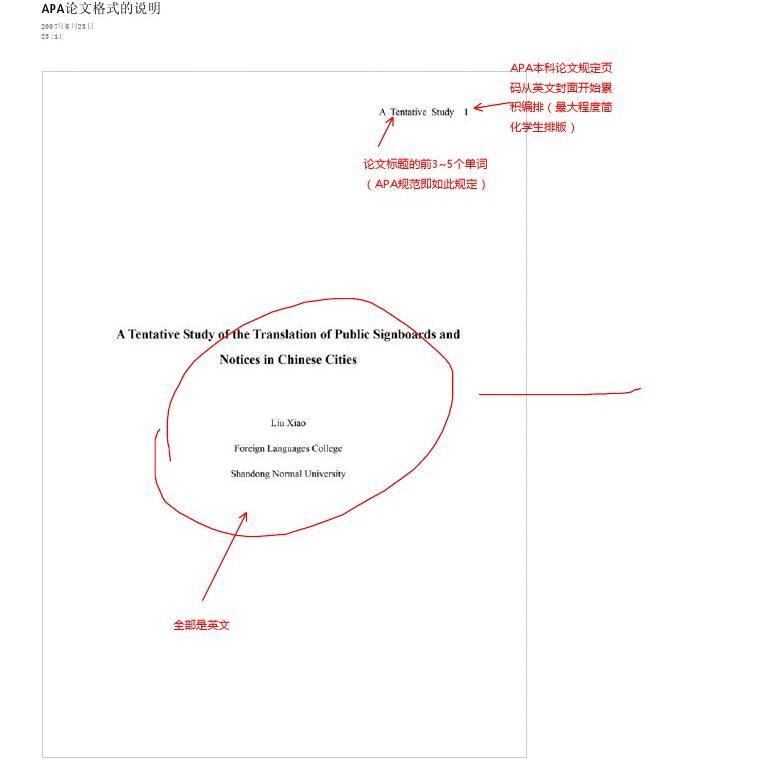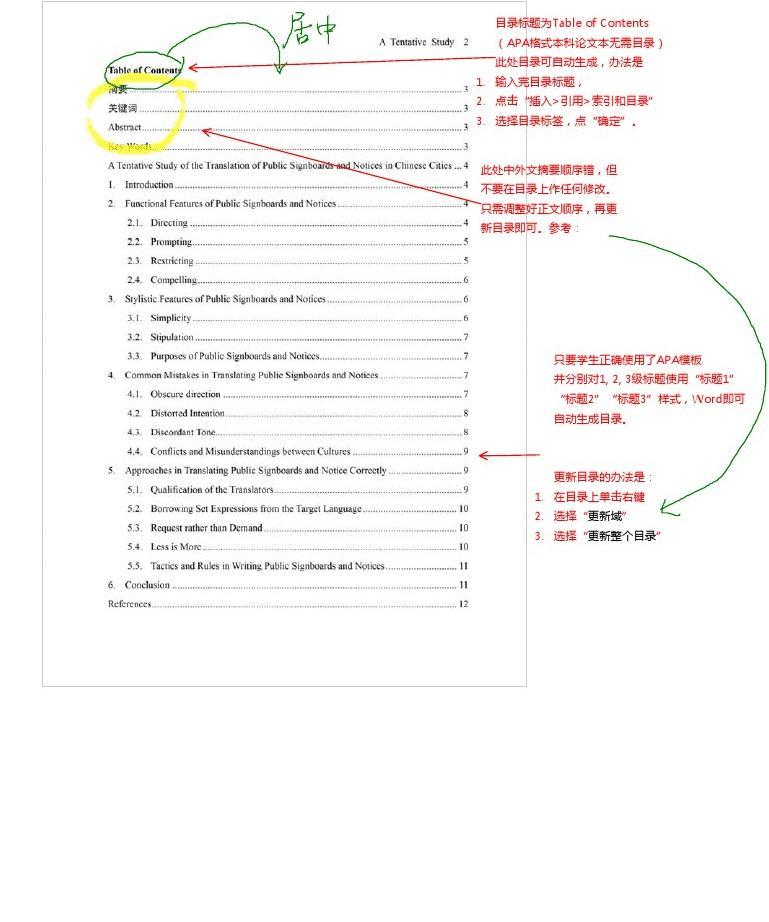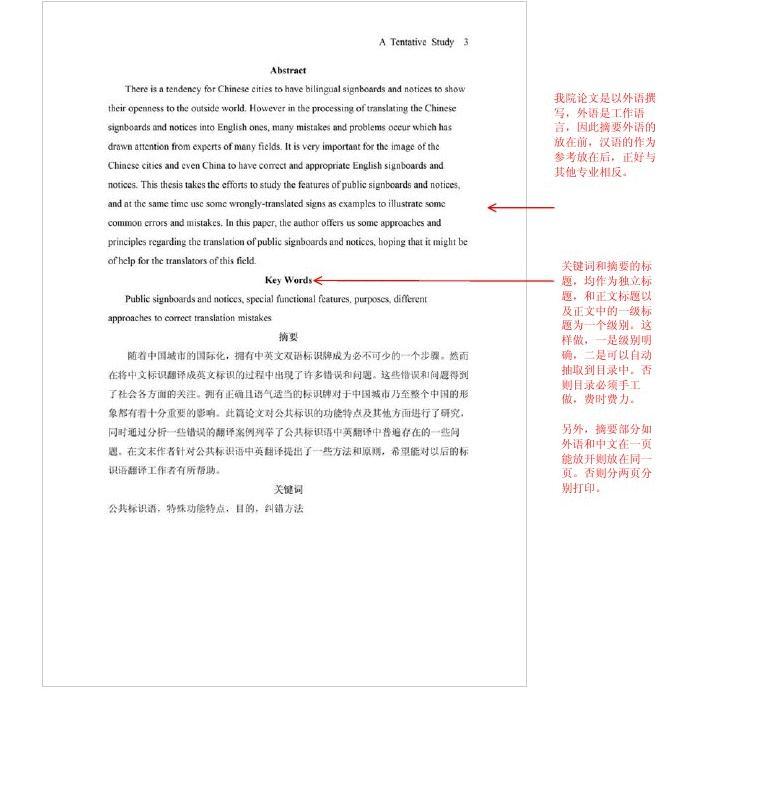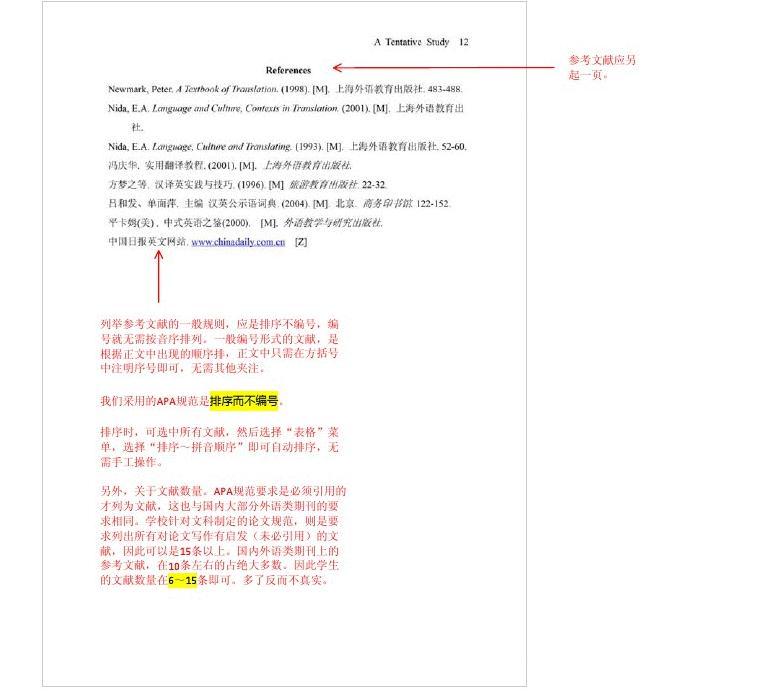APA格式(American Psychological Association)是一个为广泛接受的研究论文撰写格式,特别针对社会科学领域的研究,规范学术文献的引用和参考文献的撰写方法,以及表格、图表、注脚和附录的编排方式。
论文页面大小:A4
论文标题:字体Times New Roman;字号 16磅;行间距:2倍行间距;题目中实词第一个字母要大写;
除了文章标题以外,其他内容的字体全部使用Times New Roman;字号10磅;行间距:2倍行间距;对齐方式为两边对齐。
作者姓名、单位和电子邮件都使用单独的行并且居中,并且按照这个次序排列。单位应该包含城市,邮编和国家。
摘要(Abstract)、关键字(Keywords)这两个词要使用粗体,具体内容格式与正文相同,关键字以逗号分隔。
次级标题都需要单独一行,靠左对齐。一级标题采用粗体,标注的序号为, 2., 3. ……;二级标题采用斜体,标注的序号为1.1, 1.2, 2.1, ……;三级或者以下的标题在文章中基本上不会出现。如果需要的话,也不用单独设置格式,序号为1.1.1, 1.1.2, 2.1.1……等等。
图片的标题应该在图片下部,格式跟正文一致。标题前面加上Figure X. ,对齐方式为左对齐。
表格的标题则是在表格上部,同样左对齐,前面加上Table X. 表格内容的格式则同正文。
对于文章的公式则没有特别的要求,只要字体跟正文相近就可以了,兼顾美观。
根据APA格式,
标题是用来组织文章,使得其有层次架构。APA格式规定了文章内“标题”的特定格式(1到5级),第六版APA修订和简化的之前的标题格式。级数和格式如下:
第1级:居中的大小写标题(Centered, Uppercase and Lowercase Headings)
第2级:置中、斜体、大小写标题(Centered, Italicized, Uppercase and Lowercase Heading)
第3级:靠左对齐、斜体、大小写标题(Flush Left, Italicized, Uppercase and Lowercase Side Heading)
第4级:缩进、斜体、小写标题,最后加句号(Indented, italicized, lowercase paragraph heading ending with a period)
第5级:置中大写标题(CENTERED UPPERCASE HEADING)
例如:
(居中)Students and Teachers(Level 1)
(居中)Site of Study(Level 2)
(左对齐) School and Home Study(Level 3)
(缩进)Teachers with experience.(Level 4)
(居中)TEACHERS’CULTIVATION (Level 5)
根据APA格式,若文章标题有:
1个级数:使用第1级标题
2个级数:使用第1和第3级标题
3个级数:使用第1、第3、和第4级标题
4个级数:使用第1、第2、第3、和第4级标题
5个级数:使用第5、第1、第2、第3、和第4级标题
(按:2个级数以上以大标题→小标题方式使用)
注意:
并无六级以上的标题规定。 “Introduction”部分不需要标题,且APA格式不允许“数字”和“单一字母”出现在标题之首。
1.Place your title on the first line. Your title should reflect the scope of your paper and can be a phrase. Follow with your thesis statement in the next line. Your thesis statement should state your main point and make an assertion about the topic. The thesis statement, unlike the title, cannot be a phrase. It must be a complete sentence and should not be in question form.
1.将标题放在第一行。您的标题应该反映您论文的范围,并且可以是一个短语。在下一行中跟随您的论文陈述。您的论文陈述应陈述您的要点,并对该主题做出断言。与标题不同,论文陈述不能是短语。它必须是完整的句子,并且不能为问题形式。
2.Assign sub-topics Roman numerals using capital letters (I, II, III, IV, etc.). Divide your paper or topic into several large sections according to subject, chronology or another logical method. The sub-topics should follow the sequencing used in your paper.
2.使用大写字母(I,II,III,IV等)分配子主题罗马数字。根据主题,时间顺序或其他逻辑方法,将您的论文或主题分成几个大部分。子主题应遵循论文中使用的顺序。
3.Label supporting points. Just as the body paragraphs of your paper will include supporting sentences to provide evidence for your claims, so should the outline contain points to support your topics and sub-topics. Designate these points using capital letters (A, B, C, etc.).
3.标签支持点。就像论文的正文段落将包含佐证句以为您的主张提供证据一样,大纲也应包含支持您的主题和子主题的要点。使用大写字母(A,B,C等)指定这些点。
4.Mark further divisions with Arabic numerals (1, 2, 3, 4, etc.). If you wish to include even more detail, then designate the next level of your outline with lower-case letters (a, b, c, d, etc.). Depending upon the amount of information and length of your paper, you may decide to break down the information into even smaller categories. You can mark the next two levels of your outline with Arabic numerals within parentheses [(1), (2), etc.], followed by lower-case letters within parentheses in the next level of division [(a), (b), (c), etc.].
4.用阿拉伯数字(1、2、3、4等)标记进一步的划分。如果您希望包括更多细节,请使用小写字母(a,b,c,d等)指定下一级轮廓。根据信息量和论文长度,您可以决定将信息细分为更小的类别。您可以在括号的[(1),(2)等]中用阿拉伯数字标记大纲的下两个级别,然后在下一个除法级别[(a),(b)]中用小写字母标记在括号中,(c)等]。
5.Double-space the outline. Check to see that your page follows general APA formatting guidelines, such as using one-inch margins on all sides (top, bottom, left and right). Use a simple 10 or 12-point font such as Times New Roman or Arial.
5.对轮廓进行双倍间距。检查以确保您的页面遵循通用的APA格式准则,例如在所有侧面(顶部,底部,左侧和右侧)都使用一英寸的页边距。使用简单的10或12点字体,例如Times New Roman或Arial。
6.Balance the information. For every I in your outline, you must have a II; for every A you must provide a B, etc. If you find yourself with a stranded 1 with no 2, for example, you may need to conduct more research on the sub-topic for informational balance, or remove that level of division from the outline.
6.平衡信息。对于大纲中的每个I,您都必须有II;例如,对于每个A,您都必须提供B,等等。例如,如果您发现自己的困境1中没有2,那么您可能需要对子主题进行更多的研究以实现信息平衡,或者从大纲。
APA格式规定“参考文献”部分的人名必须以姓(Family name)的字母顺序来排列,包括名(first name)的前缀。譬如,James Smith应被改成“Smith,J.,”;Saif Al Falasi则改成“Al-Falasi, Saif.”。(阿拉伯文名字通常在姓氏和前缀之间加上连字号“−”,所以姓氏和前缀自成一体。)
纸本文献
单一作者著作的书籍:
Sheril, R. D. (1956). The terrifying future: Contemplating color television. San Diego: Halstead.
两位作者以上合著的书籍:
Smith, J., & Peter, Q. (1992). Hairball: An intensive peek behind the surface of an enigma. Hamilton, ON: McMaster University Press.
文集中的文章:
Mcdonalds, A. (1993). Practical methods for the apprehension and sustained containment of supernatural entities. In G. L. Yeager (Ed.), Paranormal and occult studies: Case studies in application (pp. 42–64). London: OtherWorld Books.
期刊中的文章(连续页码):
Crackton, P. (1987). The Loonie: God's long-awaited gift to colourful pocket change? Canadian Change, 64(7), 34–37.
期刊中的文章(非连续页码):
Rottweiler, F. T., & Beauchemin, J. L. (1987). Detroit and Narnia: Two foes on the brink of destruction. Canadian/American Studies Journal, 54, 66–146.
月刊杂志中的文章:
Henry, W. A., III. (1990, April 9). Making the grade in today's schools. Time, 135, 28-31.
报纸中的文章:
Wrong, M. (2005, August 17). Misquotes are "Problematastic" says Mayor. Toronto Sol. p. 4.
政府官方文献:
Revenue Canada. (2001). Advanced gouging: Manual for employees (MP 65–347/1124). Ottawa: Minister of Immigration and Revenue.
线上文献
针对电子文献、网站和线上文章,APA格式的网站上有订定一些基本的规则,第一就是提供读者详细的文献内容来源,第二为提供其有效的参考来源。
网络文章的打印版本
Marlowe, P., Spade, S., & Chan, C. (2001). Detective work and the benefits of colour versus black and white [Electronic version].Journal of Pointless Research, 11,123–124.
电子期刊的文章(只有网络版的期刊)
Blofeld, E. S. (1994, March 1). Expressing oneself through Persian cats and modern architecture.Felines & Felons, 4,Article 0046g. Retrieved October 3, 1999, from 网页地址
电子短信(newsletter)的文章
Paradise, S., Moriarty, D., Marx, C., Lee, O. B., Hassel, E., et al. (1957, July). Portrayals of fictional characters in reality-based popular writing: Project update.Off the beaten path, 7(3). Retrieved October 3, 1999, from 网页地址
单篇线上文献(无作者及著作日期)
What I did today.(n.d.). Retrieved August 21, 2002, from 网页地址
从大学课程或系上网站取得的文献
Rogers, B. (2078).Faster-than-light travel: What we've learned in the first twenty years.Retrieved August 24, 2079, from Mars University, Institute for Martian Studies Web site: 网页地址
从数据库搜寻的期刊文章的电子复制版本(3至5位作者)
Costanza, G., Seinfeld, J., Benes, E., Kramer, C., & Peterman, J. (1993). Minutiæ and insignificant observations from the nineteen-nineties.Journal about Nothing, 52,475–649. Retrieved October 31, 1999, from NoTHINGJournals database.
电子邮件或其他个人通讯(限定文字)
(A. Monterey, personal communication, September 28, 2001).
储存于光碟的书籍
Nix, G. (2002). Lirael, Daughter of the Clayr [CD]。New York: Random House/Listening Library.
储存于录音带的书籍
Nix, G. (2002). Lirael, Daughter of the Clayr [Cassette Recording No. 1999-1999-1999]。New York: Random House/Listening Library.




